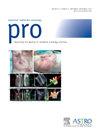完全新辅助治疗后局部胰腺癌复发的模式及其对最佳新辅助放射治疗量的影响
IF 3.4
3区 医学
Q2 ONCOLOGY
引用次数: 0
摘要
目的:绘制胰腺导管腺癌(PDAC)新辅助化疗和放疗(全新辅助治疗或 TNT)后再手术切除的局部复发图。这种复发模式将为新辅助治疗中的放射治疗计划量提供依据:方法:对2009-2022年间接受TNT治疗后进行手术治疗的局部复发病例进行放射学鉴定。使用 MIM 软件对复发灶进行单独分割,并将其合并到单个基础扫描中。所有轮廓汇编用于创建一个阈值轮廓,该阈值轮廓包括所有患者、仅头部和仅身体/尾部复发的 80%。通过测量危险器官与阈值轮廓之间的距离,为接受 TNT 治疗的患者设计出最佳临床靶体积(CTV)轮廓。复发模式也与现有的辅助治疗指南进行了比较,以评估覆盖范围:结果:查询了484名接受TNT治疗的PDAC患者的数据库。虽然局部复发在这批患者中很少见,但我们发现有80例患者出现了孤立的局部复发或同时出现局部和远处复发。我们对复发时进行了影像诊断的患者进行了鉴定。大多数复发部位部分位于已公布的轮廓指引范围内或血管外的体积扩张区,而且所有复发部位的体积覆盖率都很低。常见的复发区域包括主动脉-膈交界处、胰腺后十二指肠结节盆地以及肠系膜上动脉右侧区域。我们设计了一套新颖的新辅助治疗轮廓,以覆盖最中心的80%复发区域:结论:这是对完全接受 TNT 治疗的患者队列中局部/区域 PDAC 复发情况的最大规模收集。使用 TNT 治疗 PDAC 的局部/区域复发模式与先手术治疗的 PDAC 患者有很大不同。本文提出的新轮廓指南有助于确保高风险区域的最佳覆盖范围,避免依赖目前的辅助指南来指导治疗计划。本文章由计算机程序翻译,如有差异,请以英文原文为准。
Patterns of Locoregional Pancreatic Cancer Recurrence After Total Neoadjuvant Therapy and Implications on Optimal Neoadjuvant Radiation Treatment Volumes
Purpose
This study aimed to generate a map of local recurrences after neoadjuvant chemotherapy and radiation (total neoadjuvant therapy [TNT]) followed by surgical resection for pancreatic ductal adenocarcinoma (PDAC). Such recurrence patterns will serve to inform radiation treatment planning volumes that should be given in the neoadjuvant setting.
Methods and Materials
Locoregional recurrences after TNT followed by surgery treated between 2009 and 2022 were radiologically identified. Recurrences were individually segmented using MIM software and complied in a single base scan. All contour compilations were used to create a threshold contour encompassing 80% of recurrences among all patients, head only, and body/tail only. The distance between organs at risk and the threshold contour were measured to design an optimal clinical target volume contour for patients treated with TNT. Recurrence patterns were also compared with existing adjuvant guidelines to assess coverage.
Results
A database of 474 patients managed with TNT for PDAC was queried. While locoregional recurrences were rare in this cohort, we identified 80 patients with either isolated locoregional or simultaneous local and distant recurrences. Patients with diagnostic imaging at the time of recurrence were identified. The majority of recurrences were partially in the field of published contouring guidelines or volumetric expansions off of vessels, and volumetric coverage was low for all. Common areas of recurrence include the aorticodiaphragmatic junction, retropancreatic duodenal nodal basin, and the region to the right of the superior mesenteric artery. A novel set of proposed neoadjuvant contours was designed to cover the central-most 80% of recurrences.
Conclusions
This is the largest collection of local/regional PDAC recurrences from a cohort of patients treated exclusively with TNT. Patterns of local/regional recurrence using TNT in PDAC vary significantly from those patients with PDAC treated with a surgery-first approach. Novel contouring guidelines presented in this study can help to ensure optimal coverage of high risk regions and avoid reliance on the current adjuvant guidelines to guide treatment planning.
求助全文
通过发布文献求助,成功后即可免费获取论文全文。
去求助
来源期刊

Practical Radiation Oncology
Medicine-Radiology, Nuclear Medicine and Imaging
CiteScore
5.20
自引率
6.10%
发文量
177
审稿时长
34 days
期刊介绍:
The overarching mission of Practical Radiation Oncology is to improve the quality of radiation oncology practice. PRO''s purpose is to document the state of current practice, providing background for those in training and continuing education for practitioners, through discussion and illustration of new techniques, evaluation of current practices, and publication of case reports. PRO strives to provide its readers content that emphasizes knowledge "with a purpose." The content of PRO includes:
Original articles focusing on patient safety, quality measurement, or quality improvement initiatives
Original articles focusing on imaging, contouring, target delineation, simulation, treatment planning, immobilization, organ motion, and other practical issues
ASTRO guidelines, position papers, and consensus statements
Essays that highlight enriching personal experiences in caring for cancer patients and their families.
 求助内容:
求助内容: 应助结果提醒方式:
应助结果提醒方式:


